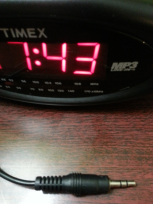 I checked into a hotel recently where the clock radio in the guest room had a conventional 3½-millimeter plug (see photo) which could be plugged into the guest’s smart phone or music player. This would permit playing music through the speaker of the clock radio. What I found amusing is what the manufacturer chose to write on the clock to let the user know about this feature — “MP3”. This is silly.
I checked into a hotel recently where the clock radio in the guest room had a conventional 3½-millimeter plug (see photo) which could be plugged into the guest’s smart phone or music player. This would permit playing music through the speaker of the clock radio. What I found amusing is what the manufacturer chose to write on the clock to let the user know about this feature — “MP3”. This is silly.
MP3 is a particular compression algorithm for storing music. But there are many other commonly used compression algorithms for music, among them WMA and OGG. By the time the music gets from the memory of the hotel guest’s phone or music player to this 3½-millimeter plug, the music has been decoded and converted to analog. The analog signal passed through the 3½-millimeter plug and its cable to the clock radio, where it passes through an (analog) audio amplifier to the speaker of the clock radio.
The point being that the clock radio neither knows nor cares whether the music it is playing was originally stored as an MP3 file. The clock radio functions identically regardless of where the analog signal came from. The clock radio could just as well play music that was originally encoded using WMA or OGG compression.
Timex, the maker of the clock radio, seems to think that “MP3” means something like “a consumer electronic device that provides an analog audio signal by means of a 3½-millimeter jack.” Or maybe Timex thinks that the average American thinks that this is what “MP3” means.

Love the article.
My opinion is the Timex is targeting an “audience” with the symbol MP3 which ironically in some way is the same “audience” for your explanation of MP3. In other words, you’re teaching an audience about the meaning of MP3, which is the same audience that Timex is targeting with the symbol MP3. The audience being one that doesn’t understand MP3.